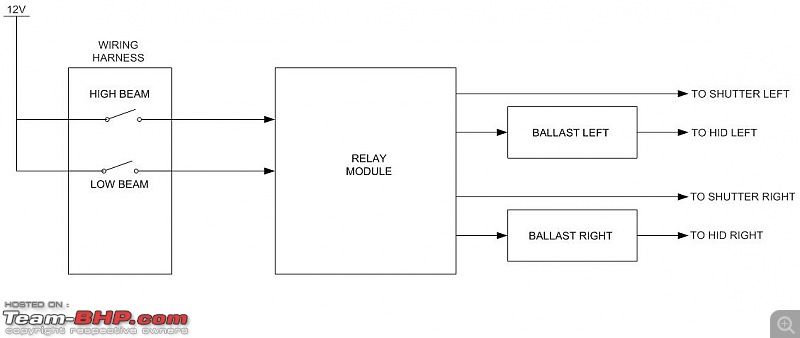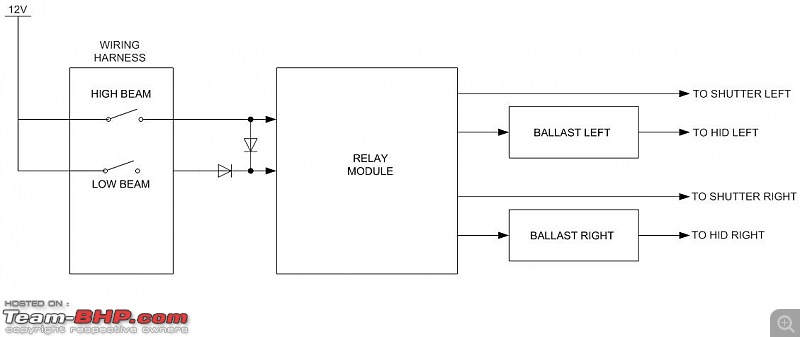Quote:
Originally Posted by sunilsoft  Hello Graaja,
I have found the following solution to the flashing light problem on a different forum:... |
This relay method may be required when the high and low beam signals from your wiring harness directly drive the ballasts. However, if you have a relay module in the present setup, you do not need a relay to achieve this function. In the other post which you have referred what the author refers as a power resistor is not a physical resistor, but the load present on the high beam signal as the high beam signal is now driving both the low and high beam inputs in flash mode. Again, this is a concern only if you are directly driving the ballasts from the low and high beam signals from the wiring harness. If you use a relay module, the low and high beam signals on the wiring harness will hardly see any load.
Below diagram shows how the high and low beam signals should be connected to the relay module. Make sure that this is the case with your wiring as well.

The relay module then supplies power to the ballast and also to the high beam shutter solenoids. During normal operation, when you turn on headlights, the low beam signal is on. The relay module now powers both the ballasts and the HID lights turn on. The shutters remain off and hence you have a restricted low beam pattern. When you turn on high beam, the low beam signal remains on, and the high beam signal also turns on. Now the shutters are operated and the beam pattern is unrestricted and is the high beam pattern.
Now with the auto head light switch, when the headlight is turned off in the daytime, both high and low beam signals are off. When you flash, the headlight switch powers both the high and low beam signals, and the low beam signal turns on the ballast and the high beam signal opens the shutter. So, you get the flash to work. This is how it works in my car.
However, if this is not working in your car, there can be two reasons.
1. When the headlight is off and you flash, the switch only turns on the high beam signal. Because of this only the shutter operates, and the light does not come on.
2. When the headlight is off and you flash, the swtich turns on both high and low beams, but for some reason your lights do not turn on.
If the issue is #1, then we can solve it using a very simple work around. To check if this is the case, follow the below test procedure (you can ask your installer to do this)
1. Take a test lamp. Connect one wire of the test lamp to the -ve of the batter or the chassis
2. Turn on the headlight. Connect the other wire of the test lamp to the low beam signal. The test lamp should glow
3. Turn on the high beam. Connect the test lamp to low beam and high beam signals. It should glow for both the signals.
4. Turn off the headlight, and just operate the flashing switch. With the test lamp test the low beam and high beam signals. If test lamp glows for both the low and high beam signals, then there is something wrong with the relay module wiring. Troubleshoot and fix.
5. If the test lamp does not glow for the low beam signal, but glows for the high beam signal, then the following workaround will solve the problem.

Introduce a diode between the low beam signal from the wiring harness and the low beam input of the relay module. The anode of the diode should be connected to the low beam signal of the wiring harness, and the cathode to the relay module. Introduce another diode between the high beam signal on the wiring signal to the low beam input of the relay module. Anode should be on the high beam signal and cathod should be on the low beam input of the relay module.
This is how the setup would work.
A diode allows signal to pass only in one direction. If there is no signal on the low beam signal and there is a signal on the high beam signal, then the diode will pass the high beam signal to the low beam input of the relay card. This will turn on the HID ballasts as well and the lights would come on. During normal operation when the low beam signal is present, the diode from the high beam signal will not do anything.
Use 1N5402 for the diodes. These diodes are rated at 200V and 3A, and so are very safely overrated for this application. You can get 1N5402 diode from any electronic shop.
The diode will look like this. The side that has the white band is the cathode.

While connecting the wires to the diodes, make sure that the joints are properly made (solered preferably), and insulated well (preferably using a TESA tape, or heat shrink tubes). Any loose connection will affect the operation of the projectors and ballasts. Also make sure your installer understands this schematic and does it correctly. Otherwise you could blow fuses or damage components.
Good luck with the DIY. Let me know how this works.
PS: If you are using the automatic headlight switch, then this switch should definitely turn on both high and low beam signals. First verify and confirm this before proceeding to the workaround.





 (1)
Thanks
(1)
Thanks

 (3)
Thanks
(3)
Thanks

 (1)
Thanks
(1)
Thanks

 (1)
Thanks
(1)
Thanks








 . When the lights controller was set to off or auto in the day time, we pulled the stalk again no lights but the shutter was responding.
. When the lights controller was set to off or auto in the day time, we pulled the stalk again no lights but the shutter was responding.